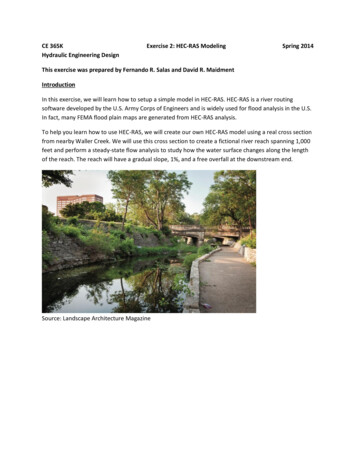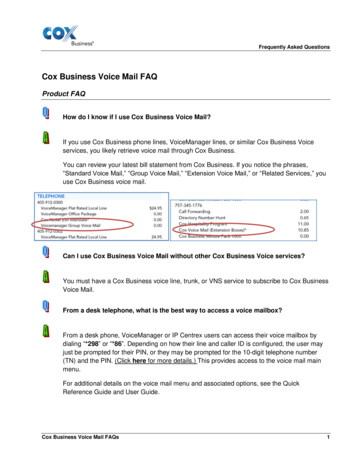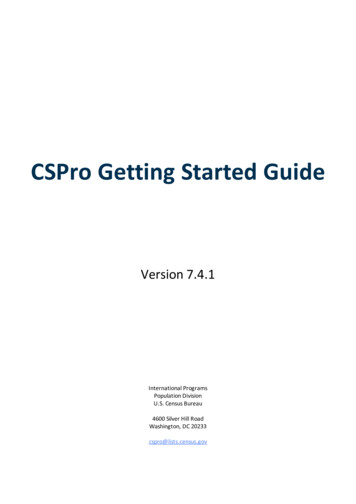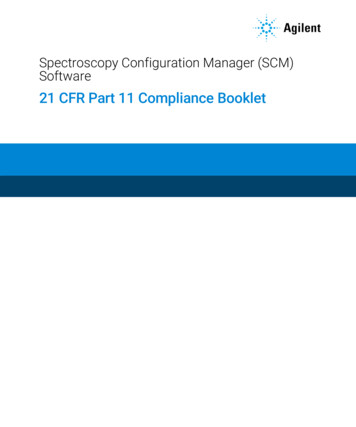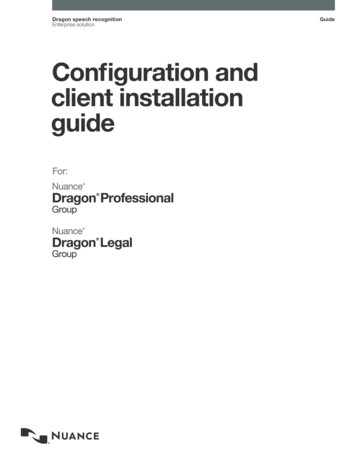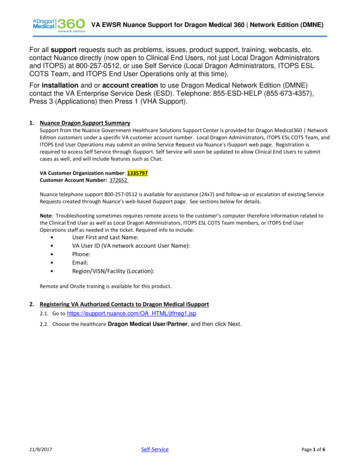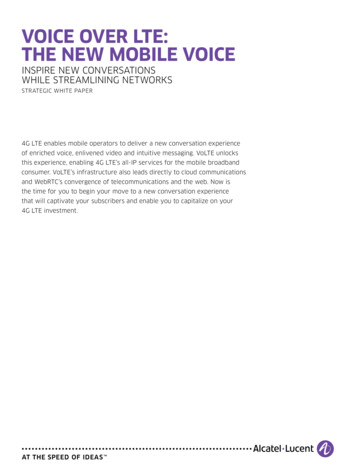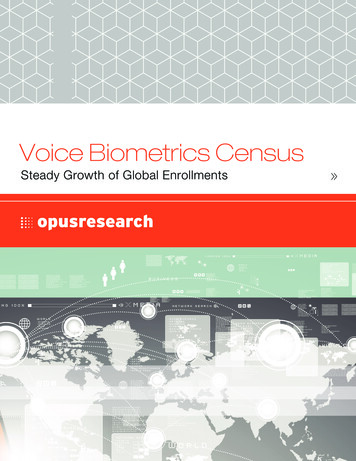
Transcription
Voice Biometrics CensusSteady Growth of Global Enrollments Report»
Report »Voice Biometrics Census»Steady Growth of Global EnrollmentsOpus Research’s latest voice biometrics census, completed in July 2016, showsdramatic growth in enrollments (more than 137 million globally), signaling voiceas a ubiquitous, highly personalized authentication factor with the capability tocombine command and control with identification and access management.»September 2016Dan Miller, Lead Analyst & Founder, Opus ResearchOpus Research, Inc.350 Brannan St., Suite 340San Francisco, CA 94107Published September 2016 Opus Research, Inc. All rights reserved.www.opusresearch.net2
Voice Biometrics Census: Steady Growth of Global Enrollments»» Table of ContentsMomentum Builds for Voice-based Authentication . . . . . . . . . . . . . . 2Impressive Global Growth Around the World . . . . . . . . . . . . . . . . 3China Syndrome: A Sea Change in Global Enrollments . . . . . . . . . . . . . 4The Western Hemisphere: Ready for Take-off . . . . . . . . . . . . . . . . 6Treating Banks as the Bellwhether . . . . . . . . . . . . . . . . . . . . 7Shortened Sales and Implementation Cycles . . . . . . . . . . . . . . . . 9Establishing a Pattern for Other Verticals . . . . . . . . . . . . . . . . . 10Dramatic Changes Afoot in Application Topology . . . . . . . . . . . . . . 12Contact Centers Remain Central . . . . . . . . . . . . . . . . . . . . 12Retooling Our Thoughts of “The Other” . . . . . . . . . . . . . . . . . . 14Ramping up for the Age of IAuth (Intelligent Authentication) . . . . . . . . . . . 14A Note on our Methodology . . . . . . . . . . . . . . . . . . . . . 15List of tablesFigure 1: Enrolled Voiceprints (Million) . . . . . . . . . . . . . . . . . . 5Figure 2: Distribution of Implementation by Enrollments . . . . . . . . . . . . 6Figure 3: Enrollments by Region . . . . . . . . . . . . . . . . . . . . 7Figure 4: Implementation by Region . . . . . . . . . . . . . . . . . . 8Figure 5: Implementation by Industry . . . . . . . . . . . . . . . . . . . 9Figure 6: Enrollments by Industry . . . . . . . . . . . . . . . . . . . 10Figure 7: Adoption-readiness by Vertical . . . . . . . . . . . . . . . . . 12Figure 8: Implementations by Application . . . . . . . . . . . . . . . . . 13Figure 9: Enrollments by Application . . . . . . . . . . . . . . . . . . 133
Voice Biometrics Census: Steady Growth of Global Enrollments»Momentum Builds for Voice-based AuthenticationIn late 2014, Opus Research conducted a global census of companies that had implemented voice biometric-basedplatforms and the number individuals who had already enrolled their voiceprints as factors for identification andverification. The census tallied over 150 instances where banks, telecommunications carriers, government agencies,healthcare/insurance companies and others were enrolling their customers and clients’ voiceprints to support strong,speedy authentication, numbering nearly 60 million globally.Opus Research’s most recent census, completed in July 2016, shows dramatic growth in enrollments (more than 137million globally) of voice biometric-based platforms while the number of instances held roughly the same. This yieldedthe following key findings: Dramatic growth fueled by large-scale implementations: The years of trials are over. Dozens ofcustomer-facing implementations have come online, each with the potential to bring millions, ratherthan thousands, of individuals into the fold. As a result, enrollments have grown 84% annually sincethe last census. Telcos and Financials led the way: Each vertical has room to grow. Telecommunication firms werefirst to have mass implementations; financials are hitting their stride, as are large-scale governmentservices. Healthcare and insurance are at an earlier stage in the adoption curve. Core technologies standing up to tests: With large financials exhibiting confidence in the accuracyand efficacy of voice-based platforms now interoperate with existing IT, security, contact center, IVRand Web frameworks, as well as platforms that support multiple factors. On the road to 1 billion enrollments: Our projection for enrollments exceeds 600 million in 2020, butthat could be quite conservative. The world’s population now approaches 7.5 billion. Mobile carriersclaim 6.8 billion subscribers, 3 billion of whom have smartphones with a high percentage protectedby a form of biometric. User acceptance is no longer a barrier (e.g. Apple reported that 89% of thepeople who own iPhones equipped with TouchID use the feature, activating the device or unlockingapps at the rate of 80 times per day).4
Voice Biometrics Census: Steady Growth of Global Enrollments»Impressive Global Growth Around the WorldAt its present rate of enrollment, by 2020, over half a billion individuals will be able to use spoken words, rather thanPINs, passwords or answers to personal questions to initiate conversations or transactions using their phones,laptops, tablets, smart speakers/appliances or connected cars. Another, equally large group of smartphone users willfind that their voice – along with images of their face, iris, ear or fingerprint – will be used to wake up the device andsign on to the services or apps that they use everyday.Figure 1: Enrolled Voiceprints 520162017201820192020Source: Opus Research (2016)The average (arithmetic mean) number of enrollees per implementation is up to 1.1 million, which represents adoubling in size when compared to the census that compiled in late 2014. If the 50 million-customer implementationin China is treated as an outlier [noted below], the average implementation still exceeds 700,000 enrollees,representing an increase of 69% over the prior census. The figure will follow this trajectory for the foreseeable futureas “proof of concepts” and “trials” give way to full-blown, customer-facing implementations.5
Voice Biometrics Census: Steady Growth of Global Enrollments»Looking at the distribution of implementations by size (Figure 2 below), there is a tranche of implementations in the5-20 million range. The bulk of implementations are in the sub 3 million range. Once in production, the number oftotal enrollments is a function of the overall size of the targeted customer cohort (e.g. high net worth individuals, bankcard customers, all customers); the marketing, education and support programs to encourage enrollment; and thenature of the underlying technology (e.g. active versus passive enrollment).Figure 2: Distribution of Implementation by Enrollments80706050403020100 100K101K-500K501K-999K1-5 Million 5 MillionSource: Opus Research (2016)Thanks to the concerted efforts of financial services giants and telecoms with customer bases that exceed 20 millionregular callers, annual growth in enrollments has averaged over 80% during the past 3 years. With governmentagencies (e.g. tax offices and social security administrations) and healthcare providers around the world ready tobring their clients, customers and citizens into the world of voice authentication, the growth curve is poised tocontinue for the foreseeable future, as depicted in Figure 1 above.China Syndrome: A Sea Change in Global EnrollmentsThere have always been pronounced differences in the adoption characteristics of the geographic regions underinvestigation. In the first census (completed late 2014), EMEA dominated the enrollment landscape, thanks largely toeffective rollout strategies by major telecommunications companies and their contact center outsourcers. This year,as depicted in Figure 3 (below), APAC now accounts for nearly half of all enrolled individuals (48%).Most notably, a single financial institution in China numbers 50 million enrolled clients. Meanwhile, global financialpowerhouse Citi, which has 15 million commercial bank customers in 12 APAC countries, expects to enroll over 1million customers in the next 12 months on its way to 3 million in three years. Likewise, Standard Chartered is rollingout a combination of biometric-based authentication offerings, including voice, for its customer base in Asia, theMiddle East and Africa.6
Voice Biometrics Census: Steady Growth of Global Enrollments»Figure 3: Enrollments by RegionNorthAmerica12%APAC48%EMEA 34%CALA6%Source: Opus Research (2016)Reflecting continued success among Turkish telecoms, coupled with bank programs in Europe and governmentinitiatives in Africa, EMEA now accounts for a third (34%) of enrolled individuals. We expect accelerated growth in theregion as the large commercial banks - like Barclays, HSBC and Lloyds, in addition to Citi -expand their voice andmulti-factor authentication initiatives to reach the lion’s share of their commercial banking customers.Looking solely at enrollments, adoption in the Western Hemisphere is noticeably lagging behind. This is not forlack of interest or attention. As reflected in Figure 4 (below), North America, alone, accounts for nearly half of theimplementations of voice biometric solutions. If you add the 5% of implementations taking place in Central Americaand Latin America (CALA), you see that 54% of all implementations are in the western hemisphere; yet they accountfor only 18% of enrolled individuals.7
Voice Biometrics Census: Steady Growth of Global Enrollments»Figure 4: Implementation by RegionAPAC11%CALA5%NorthAmerica49%EMEA 35%Source: Opus Research (2016)The Western Hemisphere: Ready for Take-offThe voice biometrics landscape in the Western Hemisphere is a combination of high-visibility contact center-basedimplementations and mobile multifactor instances, with the potential to reach tens of millions of enrollments. Theyare joined by dozens of relatively small implementations that serve as proof-of-concepts or trials designed todemonstrate the efficacy of the underlying technologies.While the trials have great growth potential, not every financial institution has the potential to grow from zero to 50million enrollments in a couple of years. Yet real world experience in Europe, the Middle East and China shows thatthe move from 10,000 to 10 million in a short period of time is very reasonable.In North America, large commercial banks and financial services companies, including RBC, Manulife and Citibankhave moved from small-scale deployments into commercial offerings that promise to add millions of new enrollees.Wells Fargo, USAA and US Bank have demonstrated convenient ways to log onto their mobile apps using their voice,face or the touch of a finger. The move to digital commerce will accelerate the deployment of more biometric access.In the Central America and Latin America (CALA), the migration from small to large-scale implementations is drivenby initiatives surrounding financial services and government entitlements. Voice biometrics solutions rose to thechallenge of enabling pensioners to supply reliable evidence that they are alive and eligible to receive their benefitsfrom government or union retirement system managers. It fights fraud for suppliers and simplifies access from thepension recipients’ point of view.8
Voice Biometrics Census: Steady Growth of Global Enrollments»With banks poised to ramp up their consumer-facing offers, government agencies are stepping up expectationsto incorporate biometric-based authentication into their service offering. North America, in particular, is poised forimpressive growth. Healthcare service providers and insurance companies have also been investigating their optionsand may be coming online in the coming years. But there are a lot of regulatory and compliance issues to settlebefore the major ramp up of enrollments commences.Treating Banks as the BellwhetherIt is no surprise that commercial banks and financial services providers are leading the charge to implement voicebased authentication. They were one of the industries to begin evaluating voice-based authentication to replace PINsand passwords over a decade ago. They were spurred on by regulators around the world who encouraged financialinstitutions to harden the security fabric and practices for phone-based commerce. They had tremendous incentiveto investigate options for layered, multifactor authentication to prevent fraudsters from successfully spoofing a realcustomer’s identity. Because phones were involved, voice was a natural factor to employ.As depicted in Figure 5, over one-third of the instances, or implementations, of voice biometrics-based solutions arefor the Finance industry. Government initiatives is second on the list, representing 23% of implementations. Telecomservice providers, which were among the early adopters of voice authentication, are in a statistical tie with Healthcareand Insurance industries with about 12% of implementations.Figure 5: Implementation by IndustryOther15%Telecom13%Healthcare/Insurance 12%Finance 37%Government23%Source: Opus Research (2016)Looking at verticals from the point of view of enrollees tells a very different story (Figure 6 below). Banking is, by farand a way, responsible for the most enrollments, with over half of all individuals. Then Telecom and Government areonce again in a virtual tie with roughly one-fifth of the total. That leaves Healthcare and Insurance with less than 5% ofthe enrolled population.9
Voice Biometrics Census: Steady Growth of Global Enrollments»Figure 6: Enrollments by IndustryHealthcare/Insurance 4%Other6%Telecom19%Government18%Finance 53%Source: Opus Research (2016)Without the 50 million new enrollees from a financial institution in mainland China, the assessment of activity wouldbe quite different. Telecom and Government, whose initiatives defined the ecosystem earlier this century, would eachhave 30% of the market. Finance would still represent a formidable share at around 25%. Healthcare/Insurancewould still hover around 5%.Shortened Sales and Implementation CyclesMany of the banks that are rolling out voice biometrics-based services in 2016 had been trialing solutions for nearlya decade. They were satisfied that the technology works and had confidence that it will do so at large scale. Changeagents or champions within the company have successfully brought key organizations into the fold. In doing so, theyhave benefit from the lessons learned by vendors, system integrators and even competitors who have had successin implementing.The upward slope of the adoption curve tells the story of overcoming long-standing technological, organizational,compliance and financial issues that prevented rapid enrollment in the past, including: Technological: Voice biometrics-based solutions have proven that they reliably detect imposters and preventfraud at large scale. In so doing, they have demonstrated compatibility with existing digital commerce andsecurity infrastructures, workflows and protocols. Organizational: With many departments involved when new security practices are adopted, solutions must be“sold” internally and wheels set in place to train the personnel involved in providing incentives for customers toenroll their voiceprints and use their voice to authenticate.10
Voice Biometrics Census: Steady Growth of Global Enrollments» Compliance-related: Legal and regulatory issues are a double-edge sword for biometrics-based solutions. On aglobal basis, they encourage implementation of layered, multi-factor, risk-aware solutions but temper adoption byoffering ambiguous guidance surrounding the treatment of biometrics as personally identifiable information (PII). Financial: Most importantly, executives must formulate a business case that reflects the financial value ofmoving to a new way of authenticating. Finance companies have done so based on reduced customer handlingexpenses resulting from shortening the time it takes to authenticate and thus totally eliminating the need to resetpasswords. They’ve coupled that with the massive savings from fraud reduction and by quantifying the financialbenefits of promoting loyalty by offering highly individualized services.Establishing a Pattern for Other VerticalsThe Finance sector provides a model that presages similar curves that we anticipate for the Government andHealthcare sectors. Each of these verticals has hundreds of millions of citizens or patients that will benefit fromsecure, highly personalized services and are addressing the adoption barriers that the Financial Services and Telcoshave already overcome.Telcos, however, are in a very pivotal position when evaluating their options for implementing voice-basedauthentication. The industry is entering its third wave of voice-based authentication, if you regard the ambitiousefforts of Bell Canada to employ the technology to authenticate customers of its residential landline services earlierthis century. Australia’s Telstra was also a pioneer in providing the hosted platform for Centrelink (the Australian socialsecurity administration) for its proof-of-life and identity authentication.As illustrated in Figure 7 (below), Telcos may be a key driver in rapid growth of enrollments, but they have issues tosort out in terms of establishing a unified identity across business units. Their lines of business include mobile andwireless services, as well as residential telephone, Internet and entertainment. They offer services to individuals, aswell as “family plans” that include small groups that may or may not be on an individual plan. What’s more, theyhave different identifiers (like phone numbers, account numbers) which may not necessarily bind an individual to aset of products and entitlements. In this context, it is hard to define when, how and why one would match a claimedidentity to a stored voiceprint.Looking at the Government vertical, it is very difficult to predict the precise timing for mass enrollments in a givensector. Based on discussions with vendors and a select group of prospective implementers, Opus Research believesthat government agencies are next up to enroll tens of millions of individuals. We’re monitoring efforts in Africa, LatinAmerica, India, Afghanistan and elsewhere where government agencies use the enrollment of a biometric (whichoften includes voice) as a means for “inclusion,” meaning eligibility to vote, carry on commerce and make or receivepayments involving the government or other citizens.11
Voice Biometrics Census: Steady Growth of Global Enrollments»Figure 7: Adoption-readiness by inanceProven for CCTR &Mobile/ MultifactorAccepted by security,CX, CCTR, MobilePCI & Privacy Shieldlaws globallyProven ROI: cost savings& fraud loss reductionTelcoProven for CCTR &Mobile/ MultifactorChallenge is acrossmultiple Business UnitsHas not proven to be anissueReduces CCTR costs,promotes loyaltyGovernmentProven & accepted inmultifactorTax, retirement, pension& “inclusion”Privacy issues &treatment of biometricsunder studyBelieved to save money;promote e-governmentTelcoProven for CCTR &Mobile/ MultifactorChallenge is acrossmultiple Business UnitsHas not proven to be anissueReduces CCTR costs,promotes loyaltyHealthcareLargely untested inCCTR/ MobleFragmented acrosspayers & providersAdds HIPAA to list ofstricturesCould prove ROI, asFinance did.The Australian Tax Office (ATO) and New Zealand Inland Revenue department are also examples where governmentefforts to incorporate voice biometrics into their identification and verification efforts is starting to accelerate in waysthat has material impact on our census.Adoption among healthcare and adjacent verticals, including pharmaceuticals, physicians’ networks, “wellness”specialists and others, is another area that is hard to handicap. Each of these fields puts high value on strongauthentication of users both for privacy protection and to provide highly personalized services. These are areas withpronounced need for communications platforms that protect privacy and rely on high-confidence that a targeted orpersonal message is being delivered to the rightful recipient.Dramatic Changes Afoot in Application TopologyThe census is proving to be a poor measure of the impact of the major forces shaping mobile and digitalcommerce, when it comes to implementations of voice biometrics by application (Figure 8). As we enter the age ofoverwhelmingly mobile and digital commerce, nearly two-thirds of the implementations of voice based authenticationtechnology remains closely mated to customer care contact centers. For the record, that is up from 41% in our lastcensus. NEARLY TWO-THIRDS OF THE IMPLEMENTATIONS OF VOICE BASEDAUTHENTICATION TECHNOLOGY REMAINS CLOSELY MATED TO CUSTOMERCARE CONTACT CENTERS. FOR THE RECORD, THAT IS UP FROM 41% INOUR LAST CENSUS.12
Voice Biometrics Census: Steady Growth of Global Enrollments»Figure 8: Implementations by ApplicationOther18%Citizen Services 5%Mobile9%Contact Center/IVR63%Password Reset 5%Source: Opus Research (2016)Indeed, the growth in contact center-based implementations coincides with a marginalizing of mobileimplementations, which accounted for less than 1% in our 2014 census. It also eclipses, to a certain extent, thenumber of instances where voice biometrics have been employed to support activities related to password reset. Inboth surveys, Citizen Services account for roughly 4-5% of implementations.Figure 9: Enrollments by ApplicationOther18%Citizen Services 5%Mobile2%Password Reset 1%Contact Center/IVR76%Source: Opus Research (2016)13
Voice Biometrics Census: Steady Growth of Global Enrollments»Contact Centers Remain CentralThe preeminence of the Contact Center in the voice biometrics world is especially pronounced when looking atenrollments (Figure 9). Over three-quarters of the people who have voluntarily enrolled their voiceprints or templateshave done so through over the phone, through contact center-based resources. This phenomenon reflects twoimportant deployment considerations. One is that contact center-based resources, including the IVR and liveagents, are instrumental in facilitating enrollments. The other is that the business case for cost-savings resulting fromshortened time to authenticate is based on the metrics and reporting that resides in the contact center. That’s why itremains central.Citizens Services is next up with a scant 5%, which is down significantly from our last census. That does not meanwe should discount the high-potential for growth in government deployments. Instead, we believe that the timingof our census may have come at the end of a period of trials and evaluations that presage mass deploymentsin the coming years. We will watch developments in this domain closely because, when they move from trials toimplementation, enrollments will take place in the tens of millions.The 2% of enrollments presented as “Mobile” also appears to be undercounting. Our theory is that we have aproblem surrounding the definition of terms used in assigning categories to applications. We know from other studiesthat as high as 85% of calls into contact centers originate from mobile phones. From the end-users’ perspective, theyare authenticating through mobile, but the authentication is taking place in an IVR or other resource closely integratedto the contact center.As these “hybrid” implementations driven by multi-channel and omnichannel user cases, Opus Research will beretooling categories and definitions to capture more accurately the technology trends and usage models.Retooling Our Thoughts of “The Other”Of great interest is (or should be) the category termed “Other.” The term is almost always used as a catch-all for itemsor activities that are not elsewhere classified. That is true in this case; yet it is important to point out, at this point inthe ecosystem’s evolution, some relevant patterns are emerging, reflecting the growth of the digital information ageand the so-called Gig Economy.Voice authentication is being pressed into service to support distance learning efforts by authenticating studentsbefore, during and after completing courses or tests. In another use case voice biometrics, in conjunction with mobilephones is used to support Time & Attendance confirmation for home healthcare workers. A similar configuration andprotocol makes it possible to track criminals who are subject to home incarceration. The list will continue to grow.Ramping up for the Age of IAuth (Intelligent Authentication)Accelerated adoption of voice biometrics-based authentication is propelled by the rapid growth of digital commercethrough mobile devices, home appliances and automotive entertainment consoles. Service and content providerstrying to reach the users through Amazon’s Alexa or GoogleNow seek simple ways for their customers or membersto assert their identity and engage in conversations over secure communications links.Voice is establishing itself as a ubiquitous user interface for the devices and services they use every day. That makesvoice biometrics an equally ubiquitous, highly personalized authentication factor with the capability to combinecommand and control with identification and access management. Simple sign-on to secure communications links14
Voice Biometrics Census: Steady Growth of Global Enrollments»via voice requires no special “reader” or proprietary piece of equipment. Plus the number of seconds of capturedspeech required for authentication is now around 10 seconds.Brands, marketers and service providers that include voice among the authentication factors they offer for simpleaccess and secure communications are already reaping the rewards of cost-savings that result from shortening thetime it takes for individuals to authenticate themselves. Further savings result from fraud loss reduction that resultsfrom early identification of imposters.Early integration of voice authentication into mobile, digital commerce offerings will have lasting value resulting fromimproved overall user experience. The full roster of biometrics – including fingerprint, face, iris – are important toolsfor personalization of digital services. In very short order, we expect voice to establish itself as the preferred modalitybecause it is one that combines physical and behavioral biometrics with the ability to give a command, initiate asearch or show emotion.The stage is set for voice-based authentication to be integrated with the rule-based engines that govern existingenterprise customer care and security solutions. As that happens and Intelligent Assistance approaches take hold,expect voice biometrics enrollments, as well as authentication and authorization events, to accelerate in parallel.A Note on our MethodologyOpus Research has complied a database of installations and estimated enrollments of voiceprints to provide asnapshot of the current voice-based authentication resources by region, application and vertical industry served. Wemake best efforts to generate accurate estimates of both installations and enrollments. We take great pains to protectthe confidence of our vendors, therefore we make no effort to calculate market share either of installed base orestimated revenue. Findings represent our best efforts to eliminate “double counting” which arise when technologiesare sold under reseller agreements and, in cases where companies provide guidance rather than numeric data.We are grateful to the community of solution vendors who provided us with the anonymized information to supportour findings and forecasts. Vendors from whom we requested and received data or guidance in our data gatheringefforts include (in alphabetical order): AGNITIO, Auraya, BioTrust, Knurld, Nuance, Sensory, Validsoft, VoiceVault andVoice Biometrics Group.15
Voice Biometrics Census: Steady Growth of Global Enrollments»About Opus ResearchOpus Research is a diversified advisory and analysis firm providing critical insight onsoftware and services that support multimodal customer care. Opus Research is focusedon “Conversational Commerce,” the merging of intelligent assistant technologies, contactcenter automation, intelligent authentication, enterprise collaboration and digital commerce.(www.opusresearch.net)For sales inquires please e-mail info@opusresearch.net or call 1(415) 904-7666This report shall be used solely for internal information purposes. Reproduction of this report without prior written permission isforbidden. Access to this report is limited to the license terms agreed to originally and any changes must be agreed upon in writing.The information contained herein has been obtained from sources believe to be reliable. However, Opus Research, Inc. accepts noresponsibility whatsoever for the content or legality of the report. Opus Research, Inc. disclaims all warranties as to the accuracy,completeness or adequacy of such information. Further, Opus Research, Inc. shall have no liability for errors, omissions or inadequacies in the information contained herein or interpretations thereof. The opinions expressed herein may not necessarily coincidewith the opinions and viewpoints of Opus Research, Inc. and are subject to change without notice.Published September 2016 Opus Research, Inc. All rights reserved.16
Source: Opus Research (2016) Reflecting continued success among Turkish telecoms, coupled with bank programs in Europe and government initiatives in Africa, EMEA now accounts for a third (34%) of
